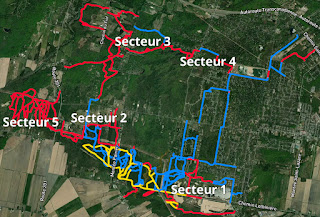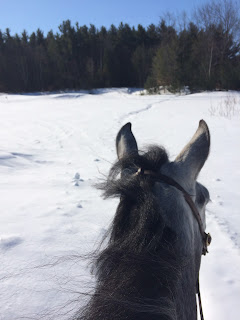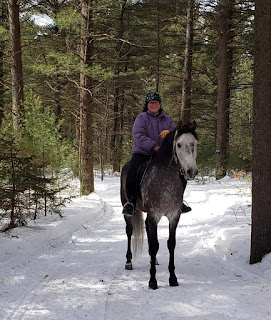The Complexity of Trail Access
Annual Trail Rides: 34/200
A century ago, local farmers in our town west of Montreal were tired of the sand left in the spring thaw that clogged the streets and ditches and created floods and ice dams to prevent passing. So the farmers got together with the town and the province to fund a reforestation project which we would later call the "Nursery". The reforestation would cover most of the old sand dunes that had been left behind many millennia ago by a retreating glacier.The old sand dunes were a popular place for local families to go for a picnic, or some fishing in some of the creeks and lakes that popped up from underground springs. Our history books show groups of families with their farmhorses pulling big sleighs or wagons filled with children. But it was time to stop the constant erosion the sand dunes were having on the local farms.
So in the 1930s began the massive reforestation project. At the time, the population of this town was under a thousand, as there was only a train that would connect with Montreal and some old country roads. A few decades later a massive highway connecting Montreal and Ottawa would bisect the town and bring about much residential development. And the train station would die.
By the 1950s and 1960s, this town became the center of the Hunt Club, gathering riders for many miles for the regular outings mostly done through private land (see sector 2 and 3 in map above). The private trails, both wide and small, had several jumps to the side that riders could choose to take. The hounds were kept in good shape, and the town became the highest concentration of horse per capita in Canada.
By the 1970s, with urban sprawl well underway, groups of developers worked with the town to subdivide lots into residential neighborhoods. There were still many massive private land owners to ensure private trails, but the pressure to develop was real.
Our riding club was created in 1990 with the objective to organize hozrsebackriders, maintain the trails, secure rights of way on private land, and negotiate trail access with the city for the municipal park that represented 30% of the trails. As this municipal park was sandwiched between two towns, there was a brief moment where each town jointly or individually "owned" the park, but generally speaking it was accessible for all citizens to walk and cross-country ski.
Our riding club struggled in those early years to gain membership which now has reached a pinacle of 1000 strong. And there was a tedious process of charting out the trails to great a network map. Fellow boarders of mine would pack their saddle bags with old-school gps units and lock in the signal if they could as they walked every trail.
Of course trails are as fickle as the weather, and trail maintenance of fallen trees, broken culverts, quicksand and bogs, became the main priority of the club for quite some time. Recruiting volunteers to sit behind a machine for 6-7 hours at a time while grooming or maintaining the trails was a chore.
Members (and those who rode the trails without membership) struggled with rules such as not riding with loose dogs, keeping your membership tag on your saddle (and paying your dues), abiding by the rules of each individual land owner about where to gallop or not and which trails were closed or open. It is a constant challenge that our volunteer board members try to uphold.
For these last years we have achieved some equilibrium with a great group of volunteers to groom and maintain the trails, financial equilibrium in maintaining the equipment, and a strong collaborative partnership with the town. Land owners are a strong fabric of our trail network and still represent the majority of our trails.
This last year has seen an incredible amount of traffic on our trails with walkers, bikers, snowshoers, skiers. And what a wonderful way to spend a sunny afternoon but to be in the forest. However, these new users are not all familiar with the sensitivity of horses nor of private land owners.
In addition, this last year has seen a pressure on urban sprawl like we have never seen. Housing prices are up 30% particularly in the periphery of Montreal, and our town is right in the hot zone. Green spaces, big lots, nice homes, lovely schooling and other amenities ... our town is very marketable.
But our town is also under pressure to preserve green spaces, and more importantly ensure the watersheds that provide the only source of water from underground springs. More development means more pressure on that water source, and it is starting to concern the residents. Most of the summer there is a shortage of water and residents are not allowed to use it to water their lawn.
The land owners see an opportunity to sell or leverage the increased value of their land, and in some cases, are pressuring the city to allow for more development projects. The city objects and is looking for a way to protect the forests and the green spaces.
While the city does own a significant part of land in the municipal park zone, most of the forest cover is on private land. And the city wants to stop or prevent any tree cutting or development on that private land. For most land owners this means a decrease in the future value of their private property and they object.
So the private land owners have pulled together and started shutting down the trail access. We saw two massive trail connectors shut down last weekend and more might follow. The town is currently doing an online (a la covid) consultation process but it really is between a rock and a hard place.
Constant development does need to consider sustainability. And forests and the natural habitat they provide are hard to replace. At the same time, it is unsustainable for the town to purchase the land which is no doubt valued at over a hundred million dollars. And in a heated housing market like this one, the pressure is real.
We are stuck in the middle, understanding the land owners and the importance of the investment they have made for some over decades, yet also understanding the town that wants to put the brakes on residential development. Not stop it entirely, just slow it down. We are also in a conflict as regular users of these trails and it is hard to see this conflict rationally as it means a direct impact on our personal pastime.
I still sing the same old tune. Prepare your horse and yourself for sharing the space with as many different types of users as possible. Eventually things will change, and we might need to move further out from Montreal to get access to these wild spaces. But if we can all come together and find a solution, maybe we can just slow the pace down and enjoy the Shinrin-Yoku (or forest bathing in Japanese).















oh how stressful that would be. I hate seeing land be lost to everyone so a few people can have homes. I always had a dream that if i won the lotter I would buy a big plot of land and set it up so people could trailer there and ride out.
ReplyDeleteThe only way to hold strong is to buy your own land. One day, maybe.
DeleteAs you can probably imagine, I relate to this entry deeply. I get so frustrated when people take access to horse trails for granted, or don't share politely with other users. It's getting harder and harder to find horse friendly property owners and parks. Being an ambassador and volunteering time and resources is so so important.
ReplyDeleteIt is a serious problem, especially near dense urban areas. But these days everybody is pouring into the local parks from some fresh air, which puts a new pressure on the systems. The private land owners are understandably dismayed by this inappropriate sense of ownership of passerby's. And every time I hear a horse back rider talk of "our trails" ... I feel the need to correct them. Until you own the land, you are but a visitor.
Delete